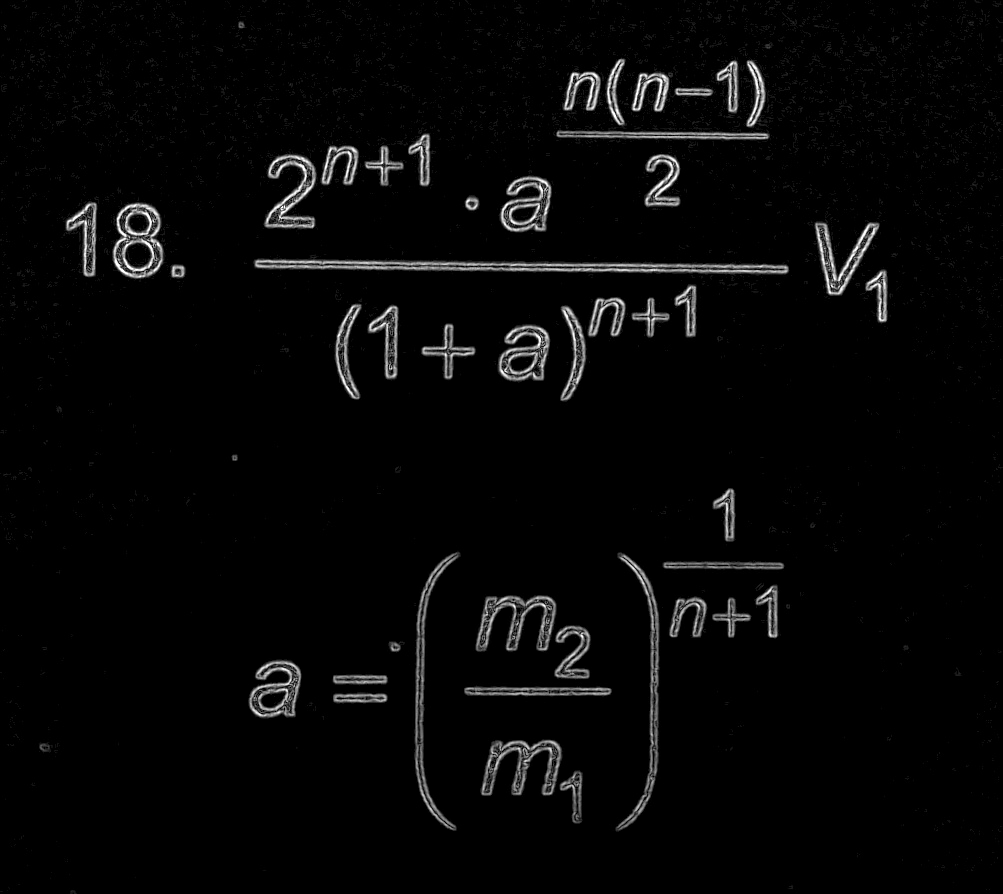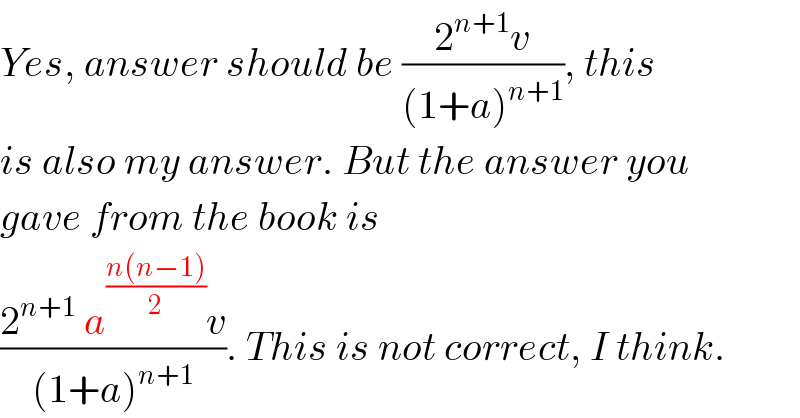Question Number 29633 by Tinkutara last updated on 10/Feb/18

Commented by Tinkutara last updated on 10/Feb/18
http://ibb.co/cyaemS
Commented by 33 last updated on 11/Feb/18

$${what}\:{are}\:{the}\:{masses}\:{of}\:{n}\:{blocs}? \\ $$
Commented by mrW2 last updated on 11/Feb/18
![Just a thought, not a proof: max. possible speed of last mass m_2 : u=v [(2/(1+((m_2 /m_1 ))^(1/(n+1)) ))]^(n+1) e.g. m_2 =2m_1 ,n=10: u≈0.703 v e.g. m_2 =0.5m_1 ,n=10: u≈1.406 v lim_(n→∞) u=(√(m_1 /m_2 )) v this is the max. possible speed which the mass m_2 can achieve by placeing infinitely many blocks between m_1 and m_2 .](https://www.tinkutara.com/question/Q29651.png)
$${Just}\:{a}\:{thought},\:{not}\:{a}\:{proof}: \\ $$$${max}.\:{possible}\:{speed}\:{of}\:{last}\:{mass}\:{m}_{\mathrm{2}} : \\ $$$${u}={v}\:\left[\frac{\mathrm{2}}{\mathrm{1}+\left(\frac{{m}_{\mathrm{2}} }{{m}_{\mathrm{1}} }\right)^{\frac{\mathrm{1}}{{n}+\mathrm{1}}} }\right]^{{n}+\mathrm{1}} \\ $$$$ \\ $$$${e}.{g}.\:{m}_{\mathrm{2}} =\mathrm{2}{m}_{\mathrm{1}} ,{n}=\mathrm{10}: \\ $$$${u}\approx\mathrm{0}.\mathrm{703}\:{v} \\ $$$$ \\ $$$${e}.{g}.\:{m}_{\mathrm{2}} =\mathrm{0}.\mathrm{5}{m}_{\mathrm{1}} ,{n}=\mathrm{10}: \\ $$$${u}\approx\mathrm{1}.\mathrm{406}\:{v} \\ $$$$ \\ $$$$\underset{{n}\rightarrow\infty} {\mathrm{lim}}{u}=\sqrt{\frac{{m}_{\mathrm{1}} }{{m}_{\mathrm{2}} }}\:{v} \\ $$$${this}\:{is}\:{the}\:{max}.\:{possible}\:{speed}\:{which} \\ $$$${the}\:{mass}\:{m}_{\mathrm{2}} \:{can}\:{achieve}\:{by}\:{placeing} \\ $$$${infinitely}\:{many}\:{blocks}\:{between}\:{m}_{\mathrm{1}} \\ $$$${and}\:{m}_{\mathrm{2}} . \\ $$
Commented by Tinkutara last updated on 11/Feb/18

Commented by Tinkutara last updated on 11/Feb/18
This is the answer. I am getting a slightly different one. I am not getting any exponent of a in numerator rest is the same.
Commented by 33 last updated on 11/Feb/18

$${what}\:{are}\:{the}\:{masses}\:{of}\:{n}\:{blocs} \\ $$$${any}\:{info}\:{given}.\:{plz}\:{tell}? \\ $$
Commented by Tinkutara last updated on 11/Feb/18
Masses of all blocks are different.
Commented by Tinkutara last updated on 11/Feb/18

$${But}\:{answer}\:{should}\:{be}\:\frac{\mathrm{2}^{{n}+\mathrm{1}} {v}}{\left(\mathrm{1}+{a}\right)^{{n}+\mathrm{1}} }\:{or} \\ $$$${you}\:{are}\:{getting}\:{another}\:{answer}? \\ $$
Commented by mrW2 last updated on 11/Feb/18

$${Yes},\:{answer}\:{should}\:{be}\:\frac{\mathrm{2}^{{n}+\mathrm{1}} {v}}{\left(\mathrm{1}+{a}\right)^{{n}+\mathrm{1}} },\:{this} \\ $$$${is}\:{also}\:{my}\:{answer}.\:{But}\:{the}\:{answer}\:{you} \\ $$$${gave}\:{from}\:{the}\:{book}\:{is} \\ $$$$\frac{\mathrm{2}^{{n}+\mathrm{1}} \:{a}^{\frac{{n}\left({n}−\mathrm{1}\right)}{\mathrm{2}}} {v}}{\left(\mathrm{1}+{a}\right)^{{n}+\mathrm{1}} }.\:{This}\:{is}\:{not}\:{correct},\:{I}\:{think}. \\ $$
Commented by Tinkutara last updated on 11/Feb/18
Thanks! I got it now. ����☺
Answered by mrW2 last updated on 12/Feb/18
![We have totally n+1 masses: M_0 , M_1 ,M_2 ,...,M_n ,M_(n+1) with M_0 =m_1 and M_(n+1) =m_2 . M_1 ,M_2 ,...,M_n are unknown and may be freely determined. For mass M_i (i=0,1,2,...,n+1) let′s assume: v_(i,1) =speed after collision with M_(i−1) v_(i,2) =speed after collision with M_(i+1) v_(0,1) =V_1 =initial speed of first mass m_1 v_(n+1,1) =V_2 =final speed of last mass m_2 Collision M_i with M_(i+1) (perfectly elastic): M_i v_(i,1) =M_i v_(i,2) +M_(i+1) v_(i+1,1) ⇒M_i (v_(i,1) −v_(i,2) )=M_(i+1) v_(i+1,1) ...(i) (1/2)M_i v_(i,1) ^2 =(1/2)M_i v_(i,2) ^2 +(1/2)M_(i+1) v_(i+1,1) ^2 ⇒M_i (v_(i,1) ^2 −v_(i,2) ^2 )=M_(i+1) v_(i+1,1) ^2 ...(ii) (ii)/(i): ⇒v_(i,1) +v_(i,2) =v_(i+1,1) take this into (i): ⇒M_i (2v_(i,1) −v_(i+1,1) )=M_(i+1) v_(i+1,1) ⇒2M_i v_(i,1) =(M_i +M_(i+1) )v_(i+1,1) ⇒(v_(i+1,1) /v_(i,1) )=(2/(1+(M_(i+1) /M_i ))) (v_(1,1) /v_(0,1) )×(v_(2,1) /v_(1,1) )×...×(v_(n+1,1) /v_(n,1) )=(2/(1+(M_1 /M_0 )))×(2/(1+(M_2 /M_1 )))×...×(2/(1+(M_(n+1) /M_n ))) ⇒(v_(n+1,1) /v_(0,1) )=(2^(n+1) /((1+(M_1 /M_0 ))(1+(M_2 /M_1 ))...(1+(M_(n+1) /M_n )))) ⇒(V_2 /V_1 )=(2^(n+1) /((1+(M_1 /M_0 ))(1+(M_2 /M_1 ))...(1+(M_(n+1) /M_n ))))=2^(n+1) F(M_1 ,M_2 ,...,M_n ) with F(M_1 ,M_2 ,...,M_n )=(1/((1+(M_1 /M_0 ))(1+(M_2 /M_1 ))...(1+(M_(n+1) /M_n )))) or F(M_1 ,M_2 ,...,M_n )=((M_0 M_1 M_2 ...M_n )/((M_0 +M_1 )(M_1 +M_2 )...(M_n +M_(n+1) ))) (∂F/∂M_i )=((M_0 M_1 M_2 ...M_n )/((M_0 +M_1 )(M_1 +M_2 )...(M_n +M_(n+1) )M_i ))−((M_0 M_1 M_2 ...M_n (M_(i−1) +M_i +M_i +M_(i+1) ))/((M_0 +M_1 )(M_1 +M_2 )...(M_n +M_(n+1) )(M_(i−1) +M_i )(M_i +M_(i+1) ))) (∂F/∂M_i )=F(M_1 ,M_2 ,...,M_n ){(1/M_i )−((M_(i−1) +2M_i +M_(i+1) )/((M_(i−1) +M_i )(M_i +M_(i+1) )))} (∂F/∂M_i )=F(M_1 ,M_2 ,...,M_n ){((M_(i−1) M_i +M_i ^2 +M_(i−1) M_(i+1) +M_i M_(i+1) −M_(i−1) M_i −2M_i ^2 −M_i M_(i+1) )/(M_i (M_(i−1) +M_i )(M_i +M_(i+1) )))} (∂F/∂M_i )=F(M_1 ,M_2 ,...,M_n ){((M_(i−1) M_(i+1) −M_i ^2 )/(M_i (M_(i−1) +M_i )(M_i +M_(i+1) )))} For F(M_1 ,M_2 ,...,M_n ) to be maximum, (∂F/∂M_i )=0, i=1,2,..,n ⇒M_(i−1) M_(i+1) −M_i ^2 =0 ⇒(M_i /M_(i−1) )=(M_(i+1) /M_i ), i=1,2,..,n i.e. M_0 , M_1 ,M_2 ,...,M_n ,M_(n+1) must buid a G.P. to get maximum for (V_2 /V_1 ), i.e. (M_1 /M_0 )=(M_2 /M_1 )=...=(M_(n+1) /M_n )=a (say) ⇒(M_1 /M_0 )×(M_2 /M_1 )×(M_3 /M_2 )×...×(M_(n+1) /M_n )=a^(n+1) ⇒(M_(n+1) /M_0 )=a^(n+1) =(m_2 /m_1 ) ⇒a=((m_2 /m_1 ))^(1/(n+1)) ⇒((V_2 /V_1 ))_(max) =(2^(n+1) /((1+a)^(n+1) )) =((2/(1+a)))^(n+1) ⇒max. V_2 =[(2/(1+((m_2 /m_1 ))^(1/(n+1)) ))]^(n+1) V_1](https://www.tinkutara.com/question/Q29677.png)
$${We}\:{have}\:{totally}\:{n}+\mathrm{1}\:{masses}: \\ $$$${M}_{\mathrm{0}} ,\:{M}_{\mathrm{1}} ,{M}_{\mathrm{2}} ,…,{M}_{{n}} ,{M}_{{n}+\mathrm{1}} \\ $$$${with}\:{M}_{\mathrm{0}} ={m}_{\mathrm{1}} \:{and}\:{M}_{{n}+\mathrm{1}} ={m}_{\mathrm{2}} . \\ $$$${M}_{\mathrm{1}} ,{M}_{\mathrm{2}} ,…,{M}_{{n}} \:{are}\:{unknown}\:{and}\:{may} \\ $$$${be}\:{freely}\:{determined}. \\ $$$$ \\ $$$${For}\:{mass}\:{M}_{{i}} \:\left({i}=\mathrm{0},\mathrm{1},\mathrm{2},…,{n}+\mathrm{1}\right)\:{let}'{s} \\ $$$${assume}: \\ $$$${v}_{{i},\mathrm{1}} ={speed}\:{after}\:{collision}\:{with}\:{M}_{{i}−\mathrm{1}} \\ $$$${v}_{{i},\mathrm{2}} ={speed}\:{after}\:{collision}\:{with}\:{M}_{{i}+\mathrm{1}} \\ $$$${v}_{\mathrm{0},\mathrm{1}} ={V}_{\mathrm{1}} ={initial}\:{speed}\:{of}\:{first}\:{mass}\:{m}_{\mathrm{1}} \\ $$$${v}_{{n}+\mathrm{1},\mathrm{1}} ={V}_{\mathrm{2}} ={final}\:{speed}\:{of}\:{last}\:{mass}\:{m}_{\mathrm{2}} \\ $$$$ \\ $$$${Collision}\:{M}_{{i}} \:{with}\:{M}_{{i}+\mathrm{1}} \:\left({perfectly}\:{elastic}\right): \\ $$$${M}_{{i}} {v}_{{i},\mathrm{1}} ={M}_{{i}} {v}_{{i},\mathrm{2}} +{M}_{{i}+\mathrm{1}} {v}_{{i}+\mathrm{1},\mathrm{1}} \\ $$$$\Rightarrow{M}_{{i}} \left({v}_{{i},\mathrm{1}} −{v}_{{i},\mathrm{2}} \right)={M}_{{i}+\mathrm{1}} {v}_{{i}+\mathrm{1},\mathrm{1}} \:\:\:…\left({i}\right) \\ $$$$\frac{\mathrm{1}}{\mathrm{2}}{M}_{{i}} {v}_{{i},\mathrm{1}} ^{\mathrm{2}} =\frac{\mathrm{1}}{\mathrm{2}}{M}_{{i}} {v}_{{i},\mathrm{2}} ^{\mathrm{2}} +\frac{\mathrm{1}}{\mathrm{2}}{M}_{{i}+\mathrm{1}} {v}_{{i}+\mathrm{1},\mathrm{1}} ^{\mathrm{2}} \:\: \\ $$$$\Rightarrow{M}_{{i}} \left({v}_{{i},\mathrm{1}} ^{\mathrm{2}} −{v}_{{i},\mathrm{2}} ^{\mathrm{2}} \right)={M}_{{i}+\mathrm{1}} {v}_{{i}+\mathrm{1},\mathrm{1}} ^{\mathrm{2}} \:\:\:\:…\left({ii}\right) \\ $$$$\left({ii}\right)/\left({i}\right): \\ $$$$\Rightarrow{v}_{{i},\mathrm{1}} +{v}_{{i},\mathrm{2}} ={v}_{{i}+\mathrm{1},\mathrm{1}} \\ $$$${take}\:{this}\:{into}\:\left({i}\right): \\ $$$$\Rightarrow{M}_{{i}} \left(\mathrm{2}{v}_{{i},\mathrm{1}} −{v}_{{i}+\mathrm{1},\mathrm{1}} \right)={M}_{{i}+\mathrm{1}} {v}_{{i}+\mathrm{1},\mathrm{1}} \: \\ $$$$\Rightarrow\mathrm{2}{M}_{{i}} {v}_{{i},\mathrm{1}} =\left({M}_{{i}} +{M}_{{i}+\mathrm{1}} \right){v}_{{i}+\mathrm{1},\mathrm{1}} \: \\ $$$$\Rightarrow\frac{{v}_{{i}+\mathrm{1},\mathrm{1}} }{{v}_{{i},\mathrm{1}} }=\frac{\mathrm{2}}{\mathrm{1}+\frac{{M}_{{i}+\mathrm{1}} }{{M}_{{i}} }} \\ $$$$\frac{{v}_{\mathrm{1},\mathrm{1}} }{{v}_{\mathrm{0},\mathrm{1}} }×\frac{{v}_{\mathrm{2},\mathrm{1}} }{{v}_{\mathrm{1},\mathrm{1}} }×…×\frac{{v}_{{n}+\mathrm{1},\mathrm{1}} }{{v}_{{n},\mathrm{1}} }=\frac{\mathrm{2}}{\mathrm{1}+\frac{{M}_{\mathrm{1}} }{{M}_{\mathrm{0}} }}×\frac{\mathrm{2}}{\mathrm{1}+\frac{{M}_{\mathrm{2}} }{{M}_{\mathrm{1}} }}×…×\frac{\mathrm{2}}{\mathrm{1}+\frac{{M}_{{n}+\mathrm{1}} }{{M}_{{n}} }} \\ $$$$\Rightarrow\frac{{v}_{{n}+\mathrm{1},\mathrm{1}} }{{v}_{\mathrm{0},\mathrm{1}} }=\frac{\mathrm{2}^{{n}+\mathrm{1}} }{\left(\mathrm{1}+\frac{{M}_{\mathrm{1}} }{{M}_{\mathrm{0}} }\right)\left(\mathrm{1}+\frac{{M}_{\mathrm{2}} }{{M}_{\mathrm{1}} }\right)…\left(\mathrm{1}+\frac{{M}_{{n}+\mathrm{1}} }{{M}_{{n}} }\right)}\: \\ $$$$\Rightarrow\frac{{V}_{\mathrm{2}} }{{V}_{\mathrm{1}} }=\frac{\mathrm{2}^{{n}+\mathrm{1}} }{\left(\mathrm{1}+\frac{{M}_{\mathrm{1}} }{{M}_{\mathrm{0}} }\right)\left(\mathrm{1}+\frac{{M}_{\mathrm{2}} }{{M}_{\mathrm{1}} }\right)…\left(\mathrm{1}+\frac{{M}_{{n}+\mathrm{1}} }{{M}_{{n}} }\right)}=\mathrm{2}^{{n}+\mathrm{1}} {F}\left({M}_{\mathrm{1}} ,{M}_{\mathrm{2}} ,…,{M}_{{n}} \right)\: \\ $$$${with} \\ $$$${F}\left({M}_{\mathrm{1}} ,{M}_{\mathrm{2}} ,…,{M}_{{n}} \right)=\frac{\mathrm{1}}{\left(\mathrm{1}+\frac{{M}_{\mathrm{1}} }{{M}_{\mathrm{0}} }\right)\left(\mathrm{1}+\frac{{M}_{\mathrm{2}} }{{M}_{\mathrm{1}} }\right)…\left(\mathrm{1}+\frac{{M}_{{n}+\mathrm{1}} }{{M}_{{n}} }\right)} \\ $$$${or} \\ $$$${F}\left({M}_{\mathrm{1}} ,{M}_{\mathrm{2}} ,…,{M}_{{n}} \right)=\frac{{M}_{\mathrm{0}} {M}_{\mathrm{1}} {M}_{\mathrm{2}} …{M}_{{n}} }{\left({M}_{\mathrm{0}} +{M}_{\mathrm{1}} \right)\left({M}_{\mathrm{1}} +{M}_{\mathrm{2}} \right)…\left({M}_{{n}} +{M}_{{n}+\mathrm{1}} \right)} \\ $$$$\frac{\partial{F}}{\partial{M}_{{i}} }=\frac{{M}_{\mathrm{0}} {M}_{\mathrm{1}} {M}_{\mathrm{2}} …{M}_{{n}} }{\left({M}_{\mathrm{0}} +{M}_{\mathrm{1}} \right)\left({M}_{\mathrm{1}} +{M}_{\mathrm{2}} \right)…\left({M}_{{n}} +{M}_{{n}+\mathrm{1}} \right){M}_{{i}} }−\frac{{M}_{\mathrm{0}} {M}_{\mathrm{1}} {M}_{\mathrm{2}} …{M}_{{n}} \left({M}_{{i}−\mathrm{1}} +{M}_{{i}} +{M}_{{i}} +{M}_{{i}+\mathrm{1}} \right)}{\left({M}_{\mathrm{0}} +{M}_{\mathrm{1}} \right)\left({M}_{\mathrm{1}} +{M}_{\mathrm{2}} \right)…\left({M}_{{n}} +{M}_{{n}+\mathrm{1}} \right)\left({M}_{{i}−\mathrm{1}} +{M}_{{i}} \right)\left({M}_{{i}} +{M}_{{i}+\mathrm{1}} \right)} \\ $$$$\frac{\partial{F}}{\partial{M}_{{i}} }={F}\left({M}_{\mathrm{1}} ,{M}_{\mathrm{2}} ,…,{M}_{{n}} \right)\left\{\frac{\mathrm{1}}{{M}_{{i}} }−\frac{{M}_{{i}−\mathrm{1}} +\mathrm{2}{M}_{{i}} +{M}_{{i}+\mathrm{1}} }{\left({M}_{{i}−\mathrm{1}} +{M}_{{i}} \right)\left({M}_{{i}} +{M}_{{i}+\mathrm{1}} \right)}\right\} \\ $$$$\frac{\partial{F}}{\partial{M}_{{i}} }={F}\left({M}_{\mathrm{1}} ,{M}_{\mathrm{2}} ,…,{M}_{{n}} \right)\left\{\frac{{M}_{{i}−\mathrm{1}} {M}_{{i}} +{M}_{{i}} ^{\mathrm{2}} +{M}_{{i}−\mathrm{1}} {M}_{{i}+\mathrm{1}} +{M}_{{i}} {M}_{{i}+\mathrm{1}} −{M}_{{i}−\mathrm{1}} {M}_{{i}} −\mathrm{2}{M}_{{i}} ^{\mathrm{2}} −{M}_{{i}} {M}_{{i}+\mathrm{1}} }{{M}_{{i}} \left({M}_{{i}−\mathrm{1}} +{M}_{{i}} \right)\left({M}_{{i}} +{M}_{{i}+\mathrm{1}} \right)}\right\} \\ $$$$\frac{\partial{F}}{\partial{M}_{{i}} }={F}\left({M}_{\mathrm{1}} ,{M}_{\mathrm{2}} ,…,{M}_{{n}} \right)\left\{\frac{{M}_{{i}−\mathrm{1}} {M}_{{i}+\mathrm{1}} −{M}_{{i}} ^{\mathrm{2}} }{{M}_{{i}} \left({M}_{{i}−\mathrm{1}} +{M}_{{i}} \right)\left({M}_{{i}} +{M}_{{i}+\mathrm{1}} \right)}\right\} \\ $$$${For}\:{F}\left({M}_{\mathrm{1}} ,{M}_{\mathrm{2}} ,…,{M}_{{n}} \right)\:{to}\:{be}\:{maximum},\:\frac{\partial{F}}{\partial{M}_{{i}} }=\mathrm{0},\:{i}=\mathrm{1},\mathrm{2},..,{n} \\ $$$$\Rightarrow{M}_{{i}−\mathrm{1}} {M}_{{i}+\mathrm{1}} −{M}_{{i}} ^{\mathrm{2}} =\mathrm{0} \\ $$$$\Rightarrow\frac{{M}_{{i}} }{{M}_{{i}−\mathrm{1}} }=\frac{{M}_{{i}+\mathrm{1}} }{{M}_{{i}} },\:{i}=\mathrm{1},\mathrm{2},..,{n} \\ $$$${i}.{e}.\:{M}_{\mathrm{0}} ,\:{M}_{\mathrm{1}} ,{M}_{\mathrm{2}} ,…,{M}_{{n}} ,{M}_{{n}+\mathrm{1}} \:{must}\:{buid} \\ $$$${a}\:{G}.{P}.\:{to}\:{get}\:{maximum}\:{for}\:\frac{{V}_{\mathrm{2}} }{{V}_{\mathrm{1}} }, \\ $$$${i}.{e}.\:\frac{{M}_{\mathrm{1}} }{{M}_{\mathrm{0}} }=\frac{{M}_{\mathrm{2}} }{{M}_{\mathrm{1}} }=…=\frac{{M}_{{n}+\mathrm{1}} }{{M}_{{n}} }={a}\:\left({say}\right) \\ $$$$\Rightarrow\frac{{M}_{\mathrm{1}} }{{M}_{\mathrm{0}} }×\frac{{M}_{\mathrm{2}} }{{M}_{\mathrm{1}} }×\frac{{M}_{\mathrm{3}} }{{M}_{\mathrm{2}} }×…×\frac{{M}_{{n}+\mathrm{1}} }{{M}_{{n}} }={a}^{{n}+\mathrm{1}} \\ $$$$\Rightarrow\frac{{M}_{{n}+\mathrm{1}} }{{M}_{\mathrm{0}} }={a}^{{n}+\mathrm{1}} =\frac{{m}_{\mathrm{2}} }{{m}_{\mathrm{1}} } \\ $$$$\Rightarrow{a}=\left(\frac{{m}_{\mathrm{2}} }{{m}_{\mathrm{1}} }\right)^{\frac{\mathrm{1}}{{n}+\mathrm{1}}} \\ $$$$\Rightarrow\left(\frac{{V}_{\mathrm{2}} }{{V}_{\mathrm{1}} }\right)_{{max}} =\frac{\mathrm{2}^{{n}+\mathrm{1}} }{\left(\mathrm{1}+{a}\right)^{{n}+\mathrm{1}} }\:=\left(\frac{\mathrm{2}}{\mathrm{1}+{a}}\right)^{{n}+\mathrm{1}} \\ $$$$\Rightarrow{max}.\:{V}_{\mathrm{2}} =\left[\frac{\mathrm{2}}{\mathrm{1}+\left(\frac{{m}_{\mathrm{2}} }{{m}_{\mathrm{1}} }\right)^{\frac{\mathrm{1}}{{n}+\mathrm{1}}} }\right]^{{n}+\mathrm{1}} {V}_{\mathrm{1}} \\ $$
Commented by Tinkutara last updated on 11/Feb/18
How can you say that maximum occurs when masses are in GP? It also requires a proof.
Commented by mrW2 last updated on 11/Feb/18
I have added the proof. But that was obvious.
Commented by Tinkutara last updated on 11/Feb/18
Thanks but we can also maximize the expression of velocity acquired by last block when there are 3 such different blocks to get relation.
Commented by mrW2 last updated on 11/Feb/18

$${That}'{s}\:{possible}\:{and}\:{easier}.\:{I}\:{wanted}\:{a} \\ $$$${general}\:{solution}\:{for}\:{any}\:{number}\:{of}\: \\ $$$${blocks}. \\ $$
